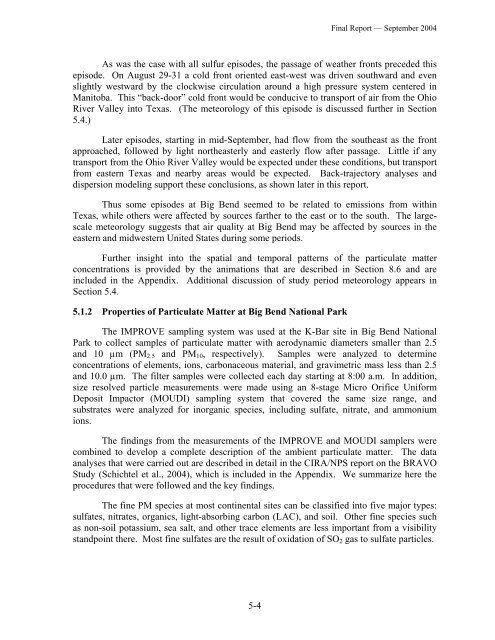(BRAVO) Study: Final Report. - Desert Research Institute
(BRAVO) Study: Final Report. - Desert Research Institute
(BRAVO) Study: Final Report. - Desert Research Institute
Create successful ePaper yourself
Turn your PDF publications into a flip-book with our unique Google optimized e-Paper software.
<strong>Final</strong> <strong>Report</strong> — September 2004<br />
As was the case with all sulfur episodes, the passage of weather fronts preceded this<br />
episode. On August 29-31 a cold front oriented east-west was driven southward and even<br />
slightly westward by the clockwise circulation around a high pressure system centered in<br />
Manitoba. This “back-door” cold front would be conducive to transport of air from the Ohio<br />
River Valley into Texas. (The meteorology of this episode is discussed further in Section<br />
5.4.)<br />
Later episodes, starting in mid-September, had flow from the southeast as the front<br />
approached, followed by light northeasterly and easterly flow after passage. Little if any<br />
transport from the Ohio River Valley would be expected under these conditions, but transport<br />
from eastern Texas and nearby areas would be expected. Back-trajectory analyses and<br />
dispersion modeling support these conclusions, as shown later in this report.<br />
Thus some episodes at Big Bend seemed to be related to emissions from within<br />
Texas, while others were affected by sources farther to the east or to the south. The largescale<br />
meteorology suggests that air quality at Big Bend may be affected by sources in the<br />
eastern and midwestern United States during some periods.<br />
Further insight into the spatial and temporal patterns of the particulate matter<br />
concentrations is provided by the animations that are described in Section 8.6 and are<br />
included in the Appendix. Additional discussion of study period meteorology appears in<br />
Section 5.4.<br />
5.1.2 Properties of Particulate Matter at Big Bend National Park<br />
The IMPROVE sampling system was used at the K-Bar site in Big Bend National<br />
Park to collect samples of particulate matter with aerodynamic diameters smaller than 2.5<br />
and 10 µm (PM 2.5 and PM 10 , respectively). Samples were analyzed to determine<br />
concentrations of elements, ions, carbonaceous material, and gravimetric mass less than 2.5<br />
and 10.0 µm. The filter samples were collected each day starting at 8:00 a.m. In addition,<br />
size resolved particle measurements were made using an 8-stage Micro Orifice Uniform<br />
Deposit Impactor (MOUDI) sampling system that covered the same size range, and<br />
substrates were analyzed for inorganic species, including sulfate, nitrate, and ammonium<br />
ions.<br />
The findings from the measurements of the IMPROVE and MOUDI samplers were<br />
combined to develop a complete description of the ambient particulate matter. The data<br />
analyses that were carried out are described in detail in the CIRA/NPS report on the <strong>BRAVO</strong><br />
<strong>Study</strong> (Schichtel et al., 2004), which is included in the Appendix. We summarize here the<br />
procedures that were followed and the key findings.<br />
The fine PM species at most continental sites can be classified into five major types:<br />
sulfates, nitrates, organics, light-absorbing carbon (LAC), and soil. Other fine species such<br />
as non-soil potassium, sea salt, and other trace elements are less important from a visibility<br />
standpoint there. Most fine sulfates are the result of oxidation of SO 2 gas to sulfate particles.<br />
5-4
















